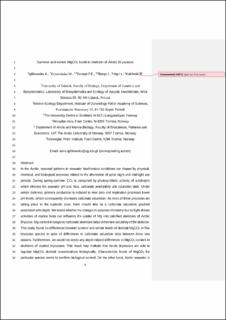| dc.contributor.author | Iglikowska, Anna | |
| dc.contributor.author | Krzemińska, Małgorzata | |
| dc.contributor.author | Renaud, Paul Eric | |
| dc.contributor.author | Berge, Jørgen | |
| dc.contributor.author | Hop, Haakon | |
| dc.contributor.author | Kuklinski, Piotr | |
| dc.date.accessioned | 2021-03-22T10:48:34Z | |
| dc.date.available | 2021-03-22T10:48:34Z | |
| dc.date.created | 2021-01-03T16:10:51Z | |
| dc.date.issued | 2020 | |
| dc.identifier.citation | Marine Environmental Research. 2020, 162 . | en_US |
| dc.identifier.issn | 0141-1136 | |
| dc.identifier.uri | https://hdl.handle.net/11250/2734779 | |
| dc.description.abstract | In the Arctic, seasonal patterns in seawater biochemical conditions are shaped by physical, chemical, and biological processes related to the alternation of seasons, i.e. winter polar night and summer midnight sun. In summertime, CO2 concentration is driven by photosynthetic activity of autotrophs which raises seawater pH and carbonate saturation state (Ω). In addition, restriction of photosynthetic activity to the euphotic zone and establishment of seasonal stratification often leads to depth gradients in pH and Ω. In winter, however, severely reduced primary production along with respiration processes lead to higher CO2 concentrations which consequently decrease seawater pH and Ω.
Many calcifying invertebrates incorporate other metals, in addition to calcium, into their skeletons, with potential consequences for stability of the mineral matrix and vulnerability to abrasion of predators. We tested whether changes in seawater chemistry due to light-driven activities of marine biota can influence the uptake of Mg into calcified skeletons of Arctic Bryozoa, a dominant faunal group in polar hard-bottom habitats. Our results indicate no clear differences between summer and winter levels of skeletal MgCO3 in five bryozoan species despite differences in Ω between these two seasons. Furthermore, we could not detect any depth-related differences in MgCO3 content in skeletons of selected bryozoans. These results may indicate that Arctic bryozoans are able to control MgCO3 skeletal concentrations biologically. Yet recorded spatial variability in MgCO3 content in skeletons from stations exhibiting different seawater parameters suggests that environmental factors can also, to some extent, shape the skeletal chemistry of Arctic bryozoans. | en_US |
| dc.language.iso | eng | en_US |
| dc.publisher | Elsevier | en_US |
| dc.rights | Attribution-NonCommercial-NoDerivatives 4.0 Internasjonal | * |
| dc.rights.uri | http://creativecommons.org/licenses/by-nc-nd/4.0/deed.no | * |
| dc.title | Summer and winter MgCO3 levels in the skeletons of Arctic bryozoans | en_US |
| dc.type | Peer reviewed | en_US |
| dc.type | Journal article | en_US |
| dc.description.version | acceptedVersion | en_US |
| dc.source.pagenumber | 14 | en_US |
| dc.source.volume | 162 | en_US |
| dc.source.journal | Marine Environmental Research | en_US |
| dc.identifier.doi | 10.1016/j.marenvres.2020.105166 | |
| dc.identifier.cristin | 1864424 | |
| dc.description.localcode | "© 2020. This is the authors’ accepted and refereed manuscript to the article. Locked until 2.10.2022 due to copyright restrictions. This manuscript version is made available under the CC-BY-NC-ND 4.0 license http://creativecommons.org/licenses/by-nc-nd/4.0/ " | en_US |
| cristin.ispublished | true | |
| cristin.fulltext | postprint | |
| cristin.qualitycode | 2 | |

